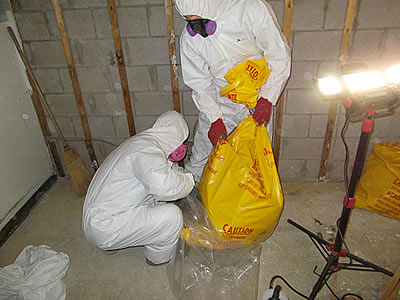Asbestos Abatement
What is Asbestos?
Chances are, when you hear the term ‘Asbestos’ you DON’T think of a rock – but that’s exactly what it is! Asbestos is a natural occurring serpentine rock that contains silicon, water and magnesium. It has been mined and used for centuries because of its durability to heat, electricity and chemical resistance. Asbestos can be pulled into a fluffy consistency, with fibers that are soft and flexible, and in proportion to their weight – stronger than steel!
Asbestos has been used for over 2000 years, with the early Greeks using Asbestos for lamp wicks. In fact, the term ‘Asbestos’ derives from the Ancient Greek “in-extinguishable”. The Romans and Egyptians used Asbestos in fabrics because it was so durable and fire resistant.
Long considered a “miracle” mineral, asbestos has been utilized in thousands of products, in everything from insulation and other construction materials to car brakes and hair dryers. Pure asbestos is an effective insulator, and it can also be mixed into cloth, paper, cement, plastic and other materials to make them stronger. At the height of its use, asbestos could be found in over 3,000 consumer products.
During WWII, the United States experienced an Asbestos Boom, with asbestos being used to build ships, submarines and even airplanes! As we mentioned earlier, asbestos is extremely heat resistant, and does not break down easily when exposed to chemicals, thus making it a seemingly perfect production material!
Shortly following WWII, in 1945, Asbestos took a turn to construction with the post war construction boom. Asbestos could be found in almost all building materials – from roofing shingles to vinyl tile flooring and literally everywhere in between.
Although its use has diminished in recent decades, there are still many products that contain asbestos, especially in older homes, schools, and public buildings.
What are the dangers of Asbestos?
It wasn’t until the late 50’s that people started to notice that factory workers, soldiers, ship builders and construction workers (pretty much everyone who had had prolonged exposure to asbestos) started to show signs of serious sickness.
Over time, researchers realized that when asbestos materials are disturbed or damaged, asbestos fibers can be released into the air and cause dangerous exposure. When people accidentally inhale or ingest the microscopic fibers, the mineral can get lodged in the lining of the lungs, esophagus and even the digestional track, eventually leading to serious health problems. Asbestos is perhaps best known for its role in causing mesothelioma, a rare and deadly cancer that can develop in linings of the lungs, abdomen, or heart.
Microscopic asbestos fibers cannot be seen, smelled or tasted, and asbestos exposure does not cause any immediate symptoms, so it is easy for a person to inhale or swallow asbestos dust without realizing it. Once asbestos fibers are in the body, they never dissolve, and the body has extreme difficulty expelling them. Over years of time, trapped asbestos fibers can cause inflammation, scarring and eventually genetic damage to the body’s cells. Asbestos exposure can take from 10 to 40 years to develop signs.
Asbestos was used in thousands of commercial products and industrial capacities and those working with the material in these industries are potentially at risk of harmful exposure.





